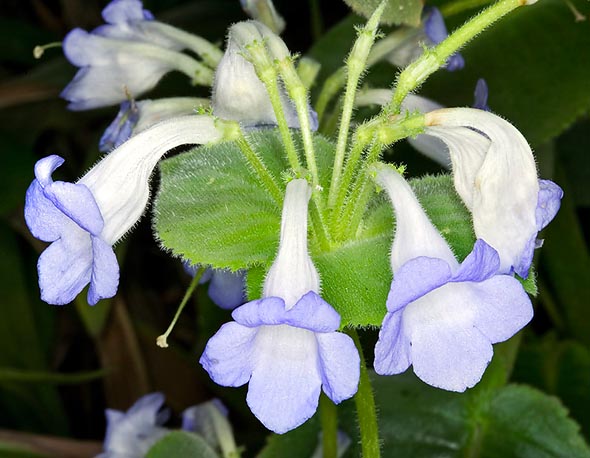Family : Gesneriaceae

Text © Pietro Puccio

English translation by Mario Beltramini

The Chirita lavandulacea is an annual herb for warm and humid climates © Giuseppe Mazza
The name of the genus comes from the local Hindustani name of one of the species; the Latin name of the species refers to the resemblance of the colour of its flowers with that of the common lavender (Lavandula angustifolia).
Common names: Hindustan gentian, lavender chirita (English).
The Chirita lavandulacea Stapf (1925) is an upright-growing annual herb which does not usually exceed the 50 cm, with elliptic opposite leaves of a pale green colour, rather delicate, tomentose, 5-18 cm long and 3-10 cm broad, with indented margins.
The axillary flowers appear in summer-autumn and are bent, funnel-shaped, of about 3 cm of diameter, of a pale lavender colour with white throat.
It reproduces by seed in late winter-early spring in substrata mainly formed by coarse siliceous sand, agri perlite, vermiculite or other much draining material, under glass or other transparent material in order to keep a high level of humidity, at a temperature of 20-22 °C.
Its positioning must be very luminous, but not under direct sun. It may also reproduce by stem or also leaf cutting, in spring.
It is a little diffused species, usually cultivated by the lovers of gesneriaceans, it requires a partial shaded position and rich of humus soils, with addiction of coarse siliceous sand or agri perlite for about the 30% in order to improve the draining.
It needs a high ambient humidity, therefore is suitable for tropical and humid subtropical climates, even if, being an annual plant, it may be cultivated in a vast variety of climates, but the rigid ones, taking care to furnish the right degree of humidity of the air and to keep the substratum constantly humid, but without stagnations which may reveal harmful.
For the plants cultivated in pot, in rather dry locations, the humidity may be increased by placing the pot on a large saucer full of expanded clay or gravel, not in direct contact with the bottom of the pot; the nebulisations which easily cause harm to the leaves are to be avoided.
→ To appreciate the biodiversity within the GESNERIACEAE family please click here.
